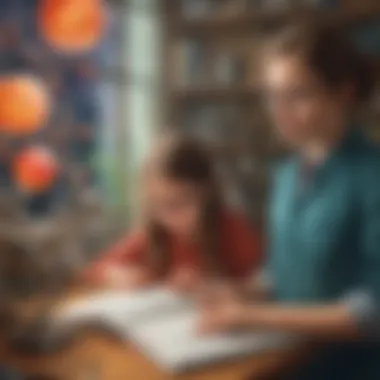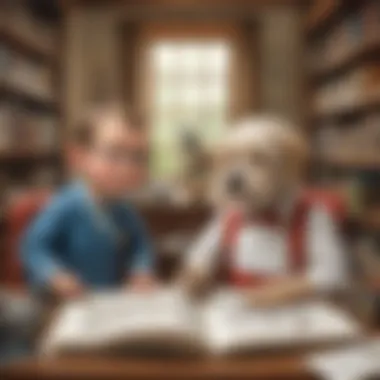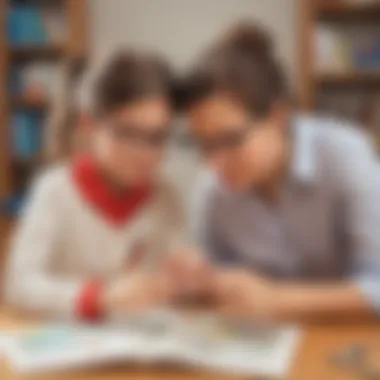Unveiling the Wonders of LabLittles: Journal Buddies for Young Science Enthusiasts


Science Fun Facts
LabLittles' journal buddies include a plethora of fascinating science fun facts aimed at sparking curiosity in young minds. From the discovery of the smallest particles to the vastness of the universe, children are exposed to interesting trivia and facts that ignite a sense of wonder and intrigue in the world around them. This section serves as a foundation for building a solid scientific understanding while engaging children through quirky science stories and mind-boggling records. Additionally, it presents thought-provoking questions that encourage critical thinking and exploration.
Discover the Wonders of Science
Dive deep into the enchanting realm of LabLittles' journal buddies, where young science enthusiasts unravel the mysteries of the universe through interactive and educational content. Through engaging videos and animations, children are transported into the realm of science, where complex concepts are simplified for easy understanding. The platform features interactive learning tools that facilitate hands-on exploration of scientific phenomena, making learning both fun and informative. Furthermore, real-life applications of science highlight the relevance of scientific principles in everyday life, fostering a deeper appreciation for the subject.
Science Quiz Time
Engage in a stimulating journey of discovery with LabLittles' science quizzes, meticulously designed to test young minds' comprehension and knowledge. Featuring a collection of multiple-choice questions, brain teasers, and puzzles, this section challenges children to apply their scientific understanding in a fun and interactive way. By blending education with gamification, these quizzes transform learning into an exciting adventure, allowing children to deepen their scientific knowledge in an engaging and entertaining manner.
Science Experiment Showcase
Embark on a hands-on exploration of science with LabLittles' journal buddies, as they unveil a world of fun and engaging experiments for young scientists. Each experiment is accompanied by detailed step-by-step instructions, ensuring that children can conduct them safely and independently. A comprehensive materials list equips young scientists with everything they need to bring each experiment to life, while safety tips and precautions ensure a secure and controlled learning environment. By showcasing the thrilling side of science through hands-on experimentation, this section ignites a passion for discovery and inquiry in children, nurturing the scientists of tomorrow.
Introduction to Journal Buddies
In this fascinating delve into the realm of science exploration for young minds, the concept of journal buddies takes center stage. Journaling plays a pivotal role in enhancing learning experiences, sparking curiosity, and encouraging reflection at a young age. LabLittles, a captivating infotainment platform, serves as the perfect backdrop for this exciting journey. Through a blend of education and entertainment, journal buddies aim to nurture a love for science among children aged 6-12, laying the foundation for lifelong learning.
Understanding the Concept of Journal Buddies
What are Journal Buddies?
Journal buddies refer to interactive tools or companions that aid children in documenting their scientific inquiries, discoveries, and reflections. These companions can be in the form of physical journals, digital platforms, or even collaborative projects with peers. The essence of journal buddies lies in providing a structured yet creative outlet for young science enthusiasts to express their thoughts and observations methodically. By fostering a sense of ownership and organization, journal buddies empower children to take charge of their learning journey, cultivating independence and critical thinking skills.
Benefits of Keeping a Science Journal
Keeping a science journal offers a myriad of advantages for young learners embarking on their scientific quests. From honing writing skills to enhancing observational abilities, maintaining a science journal cultivates a holistic approach to learning. Through journaling, children can track their progress, analyze results, and communicate their findings effectively. The act of journaling not only consolidates knowledge but also fosters a sense of accomplishment and pride in scientific exploration.
Importance of Journal Buddies for Young Science Enthusiasts


Enhancing Learning Through Journaling
Journal buddies serve as powerful tools for enhancing learning experiences by encouraging active engagement with scientific concepts. By documenting experiments, observations, and inquiries in a systematic manner, children can reinforce their understanding of scientific principles and processes. Through regular journaling, young science enthusiasts develop a deeper connection with the subject matter, fostering retention and comprehension.
Encouraging Curiosity and Exploration
One of the key benefits of journal buddies is their ability to fuel curiosity and exploration in young minds. By providing a platform for expressing ideas, posing questions, and seeking answers, journal buddies empower children to embrace their natural curiosity. Through journaling, young science enthusiasts can embark on a journey of discovery, exploring new concepts, and delving into the wonders of the scientific world with enthusiasm and inquisitiveness.
Getting Started with Journal Buddies
In this section, we will delve into the essential initial steps of embarking on the journaling journey with your little science enthusiasts. Finding a worthy start is crucial, setting the tone for a fruitful exploration. Beginning the journaling process not only cultivates a habit but also nurtures feelings of accomplishment and creativity. Sparking curiosity and igniting a passion for science, getting started with journal buddies lays the foundation for a lifelong love of learning.
Setting Up Your Science Journal
Choosing the Right Journal Format
When it comes to selecting the ideal journal format, various factors come into play. The right format can significantly enhance the journaling experience, offering ease of use, organization, and functionality. Opting for a format that aligns with the child's preferences and learning style is key. Whether it's a structured template or a blank canvas for creativity, the chosen format should resonate with the young scientist, encouraging regular entries and engagement.
Essential Supplies for Journaling
Equipping your young science enthusiast with the necessary supplies is paramount to a successful journaling experience. From colorful pens and markers to rulers and stickers, each item plays a role in fostering creativity and expression. Choosing quality supplies ensures durability and reliability, enhancing the longevity of the journal. While the type of supplies may vary based on individual preferences, having a well-stocked kit ensures that the budding scientist is ready to document their scientific endeavors with enthusiasm and flair.
Exploring Different Journaling Techniques
Visual Journaling
Visual journaling offers a creative outlet for young scientists to express their observations and thoughts through images and drawings. This technique allows for a unique visualization of scientific concepts, making learning more engaging and memorable. Visual elements can range from sketches of experiments to diagrams illustrating hypotheses, bringing a new dimension to the journaling experience.
Written Reflections and Observations
Incorporating written reflections and observations in the science journal provides a structured approach to recording discoveries and insights. Encouraging children to articulate their thoughts in writing fosters language development and critical thinking skills. Through written entries, young scientists can document their observations, analyze results, and make connections between different scientific concepts, enhancing their understanding and communication skills.


Creating Engaging Content in Your Science Journal
Fun Experiments to Document
Documenting fun experiments not only adds depth to the journal but also allows young scientists to revisit and reflect on their scientific endeavors. Choosing exciting experiments to document sparks curiosity and drives exploration. From erupting volcanoes to homemade slime, each experiment presents an opportunity to learn, discover, and document the scientific process.
Creative Ways to Record Learnings
Recording learnings in creative ways injects fun and enthusiasm into the journaling experience. Encouraging children to think outside the box and explore unconventional methods of documentation cultivates a sense of innovation and inventiveness. Whether it's through storytelling, comic strips, or interactive elements, embracing creativity enhances the learning journey and makes the science journal a truly personalized and engaging tool for growth.
Utilizing Journal Buddies for Learning and Growth
Journal Buddies serve as invaluable tools for young science enthusiasts to enhance their learning journey. Through consistent journaling, children can document their scientific experiences, observations, and reflections, fostering a deeper understanding of scientific concepts. By utilizing Journal Buddies, kids can cultivate critical thinking skills, encourage curiosity, and stimulate a passion for exploration and experimentation. The act of chronicling their scientific endeavors not only consolidates their learning but also allows for self-assessment and growth.
Developing Critical Thinking Skills Through Journaling
Analyzing Experiment Results
Analyzing experiment results plays a pivotal role in honing children's analytical abilities within the scientific realm. By scrutinizing data, identifying patterns, and drawing conclusions, young learners can develop a keen eye for detail and precision. This process instills a sense of systematic reasoning and logical deduction, integral to the scientific method. Through analyzing experiment results, children can refine their problem-solving skills and grasp the significance of empirical evidence in shaping scientific understanding.
Making Connections Between Concepts
Linking various scientific concepts together is a fundamental aspect of journaling that promotes a holistic understanding of the subject matter. By identifying interrelations between experiments, theories, and observations, children can synthesize information into coherent frameworks. Making connections between concepts enables young scientists to contextualize knowledge, identify trends, and draw parallels between different scientific phenomena. This practice not only enhances their comprehension but also nurtures a more profound appreciation for the interconnectedness of scientific principles.
Enhancing Communication and Expression
Articulating Ideas Clearly
Effective communication is key to sharing scientific discoveries and insights with clarity and precision. By articulating ideas clearly in their journals, children develop their verbal and written communication skills. Clear expression not only helps in conveying thoughts logically but also cultivates the ability to structure information cohesively. Articulating ideas facilitates the sharing of knowledge, promotes collaborative learning, and encourages constructive feedback, fostering a communicative environment conducive to scientific exploration.
Sharing Discoveries with Others


Sharing discoveries with peers and mentors is a pivotal aspect of the scientific journey, facilitating collective learning and exchange of perspectives. By documenting and sharing their findings, children not only strengthen their understanding but also contribute to a collaborative scientific community. Sharing discoveries encourages engagement, inspires curiosity in others, and cultivates a sense of camaraderie among young science enthusiasts. This collaborative approach to journaling fosters a nurturing environment where ideas flourish and knowledge is shared seamlessly.
Fostering a Lifelong Love for Science
Building a Personal Portfolio of Science Adventures
Creating a personal portfolio of science adventures through journaling offers children a sense of ownership over their scientific explorations. By curating a collection of experiments, observations, and reflections, young learners create a rich tapestry of their scientific pursuits. Building a personal portfolio not only inspires a sense of accomplishment but also serves as a visual representation of their growth and learning trajectory. This personalized archive of science adventures becomes a cherished memento, reflecting the evolution of their scientific curiosity and achievements.
Inspiring Others Through Your Journal
The act of sharing one's scientific journey can be a powerful source of inspiration for peers, friends, and aspiring science enthusiasts. By documenting their explorations, insights, and breakthroughs, children can inspire others to embark on their scientific quests. Through their journal entries, young scientists can ignite curiosity, spark interest in STEM disciplines, and demonstrate the joy of scientific inquiry. Inspiring others through their journals creates a ripple effect of enthusiasm, curiosity, and passion for science, fostering a community of young minds driven by a shared love for exploration and discovery.
Exploring Advanced Journaling Concepts
In this section, we delve into the critical topic of exploring advanced journaling concepts. For young science enthusiasts aged 6-12, understanding the intricacies of journaling can significantly enhance their learning experience. By incorporating advanced techniques, children can elevate their scientific observations and reflections to a more sophisticated level. Advanced journaling concepts offer a gateway to deeper exploration and analysis of scientific phenomena, fostering a holistic understanding of the world around them. Through this section, readers will gain valuable insights into leveraging technology and collaboration to enrich their science journaling journey.
Incorporating Technology in Your Science Journal
Technology plays a pivotal role in modern journaling practices, revolutionizing how young scientists document their discoveries. Within the realm of digital journaling tools, children can seamlessly integrate photos, videos, and interactive elements into their journals, creating dynamic and engaging content. The accessibility and user-friendly interfaces of digital tools make them ideal for young learners to express their thoughts and findings effortlessly. Despite the advantages of digital journaling tools, it is essential to balance screen time and hands-on experiences to maintain a well-rounded approach to scientific inquiry.
Digital Journaling Tools
Digital journaling tools offer versatility and convenience, allowing young scientists to capture their observations in innovative ways. The ability to annotate images, add audio notes, and organize information digitally enhances the quality of their journal entries. One key characteristic of digital tools is their ability to facilitate multimedia integration, encouraging children to explore varied modes of expression. However, it is crucial to monitor screen time and ensure that the use of digital tools complements rather than replaces tangible experimentation and observation in the scientific process.
Online Platforms for Sharing
Online platforms present an excellent opportunity for young scientists to showcase their journaling efforts and connect with like-minded individuals. These platforms provide a virtual space for sharing experiments, insights, and discoveries, fostering a sense of community among young science enthusiasts. By sharing their journal entries online, children can receive feedback, spark discussions, and inspire others with their scientific endeavors. While online platforms offer broad visibility and networking opportunities, it is important to prioritize privacy and online safety when engaging in virtual science communities.
Collaborative Journaling Projects
Collaboration is a cornerstone of scientific inquiry, and collaborative journaling projects offer young scientists a platform to co-create and exchange ideas. By partnering with peers for joint entries, children can benefit from diverse perspectives, peer support, and collective problem-solving. Collaborative journaling nurtures teamwork skills, communication abilities, and mutual learning as young scientists navigate shared scientific experiences.
Partnering with Peers for Joint Entries
Partnering with peers for joint entries cultivates a collaborative spirit among young scientists, encouraging teamwork and knowledge sharing. The key characteristic of this collaborative approach lies in its capacity to synergize individual strengths and insights towards a common scientific goal. By engaging in joint entries, children can broaden their scientific horizons, build camaraderie with peers, and co-create meaningful scientific narratives. However, coordinating schedules, managing expectations, and respecting diverse viewpoints are essential considerations for successful collaborative journaling projects.
Creating Group Science Journals
Group science journals enable children to embark on scientific adventures collectively, fostering a sense of camaraderie and shared learning. The key characteristic of creating group science journals is the collaborative effort in documenting group experiments, observations, and reflections. By pooling their resources, ideas, and creativity, young scientists can coalesce their individual perspectives into a comprehensive scientific narrative. Group science journals promote teamwork, communication skills, and a sense of collective achievement, laying the foundation for collaborative exploration and discovery. However, maintaining equal participation, cultivating inclusive environments, and valuing each member's contributions are vital for the success of group science journal projects.







